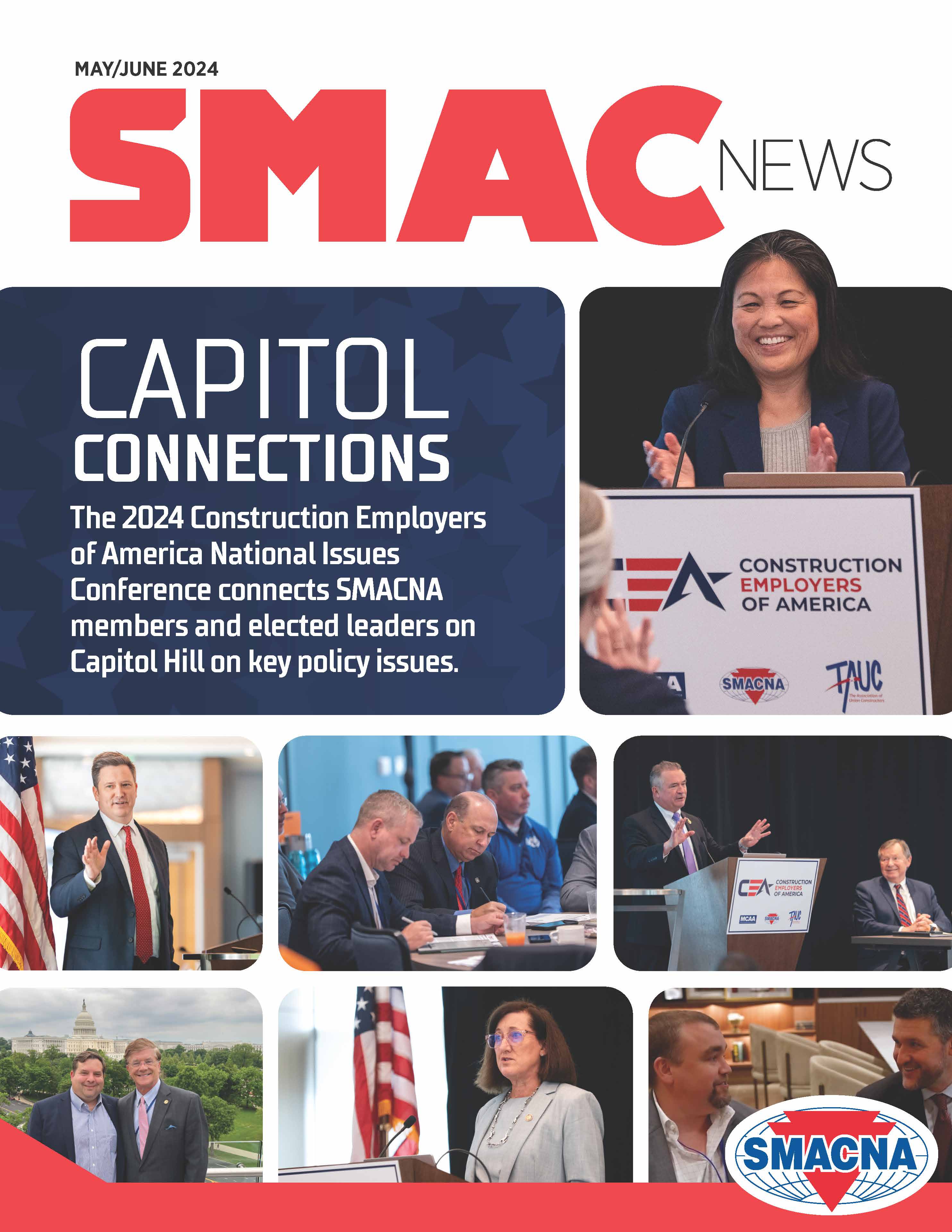Understanding Overtime Challenges: Bonuses and Incentive Payments
While SMACNA contractors are familiar with the concept of “overtime” — that is, paying employees time and one-half for certain hours worked — few contractors understand how overtime paid pursuant to their collective bargaining agreement (or “CBA”)

Grant Collins
While SMACNA contractors are familiar with the concept of “overtime” — that is, paying employees time and one-half for certain hours worked — few contractors understand how overtime paid pursuant to their collective bargaining agreement (or “CBA”) intersects with statutory overtime required by the federal Fair Labor Standards Act (or “FLSA”).
Statutory overtime, particularly the calculation of the “regular rate” as it relates to bonuses and incentive pay, can be a potential minefield for contractors.
These are some specifics to pay attention to.
BONUSES AND INCENTIVE PAYMENTS LIKELY MUST BE INCLUDED IN THE “REGULAR RATE” UNDER THE FLSA
Contractors that are paying bonuses or “incentive pay” to employees who travel to a certain area or for working a certain number of hours each week likely need to include these amounts in the calculation of the “regular rate.”
According to the DOL regulations, bonuses — like an incentive pay bonus or an attendance bonus — typically need to be included in the “regular rate.”
Bonuses which are announced to employees to induce them to work more steadily or more rapidly or more efficiently or to remain with the firm are regarded as part of the regular rate of pay. Most attendance bonuses, individual or group production bonuses, bonuses for quality and accuracy of work, bonuses contingent upon the employee's continuing in employment until the time the payment is to be made and the like are in this category; in such circumstances they must be included in the regular rate of pay.
The DOL’s Field Operations Handbook includes the following “examples of bonuses which would normally be included in the regular rate . . .”:
- Production bonuses, bonuses paid for performing work in less than an established standard time.
- Bonuses paid when certain types of merchandise are sold through an employee’s effort, cost-of-living bonuses, attendance bonuses and bonuses paid as incentives to attract employees to an isolated or otherwise undesirable job site.
That is, all of the bonuses listed above must generally be included in the calculation of the “regular rate.” Given this guidance, it seems clear that bonuses or incentive pay designed to encourage employees to travel to certain areas or to work a certain number of hours each week likely must be included in the “regular rate” for purposes of calculating statutory overtime.
Consider the following example: An employee earns $20 per hour and works 50 hours (10 hours Monday through Friday) in a workweek. In the absence of any additional compensation, the employee would earn $800 in straight time (40 hours x $20) and $300 in overtime (10 hours x $30 per hour) for a total of $1,100 in weekly compensation. Alternatively, using the regular rate calculation above, the employee earned $1,000 in straight time compensation (50 hours x $20). Dividing that by the 50 hours worked, results in a “regular rate” of $20 per hour. Multiplying the regular rate ($20) by .5 and then by 10 hours (i.e., the number of overtime hours in the workweek) results in an overtime premium of $100. Thus, the employee’s total weekly compensation is $1,100 ($1,000 in straight time + $100 in overtime premium).
If, however, the employee also receives a $100 bonus if the employee works at least 10 hours each day (for a total of $500), then the employee’s statutory overtime compensation would also increase. Specifically, using the calculation above, the employee would earn $1,000 in straight time compensation (50 hours x $20) and $500 in bonuses (i.e., $100 for each 10-hour day). This total ($1,500), divided by 50 hours worked, results in a regular rate of $30 per hour (instead of $20 per hour in the example above). Multiplying the regular rate ($30) by .5 and then by 10 hours (i.e., the number of overtime hours) results in an overtime premium of $150. Thus, the total weekly compensation is $1,650 ($1,000 in straight time + $500 in bonuses + $150 in overtime premium).
As you can see, paying bonuses and other amounts that cannot be excluded from the regular rate of pay can quickly complicate the calculation of the statutory overtime premium and result in a potential FLSA violation.
CONTRACTUAL OVERTIME MAY BE OFFSET AGAINST STATUTORY OVERTIME
Even though additional statutory overtime may be owed for certain bonuses that should have been included in the regular rate under the FLSA, the employee may not be owed any additional compensation if he or she already received contractual overtime premiums in excess of the statutory overtime premiums owed under the FLSA.
The DOL regulations say contractual overtime premiums paid by the employer for daily overtime, weekend overtime and double-time may be offset against the employer’s statutory overtime owed under the FLSA.
Specifically, the DOL regulations provide: "Where overtime rates are paid pursuant to statute or contract for hours in excess of 8 in a day, or in excess of the applicable maximum hours standard, or in excess of the employees' normal working hours or regular working hours (as under section 7(e)(5) or for work on 'special days' (as under section 7(e)(6), or pursuant to an applicable employment agreement for work outside of the hours established in good faith by the agreement as the basic, normal, or regular workday (not exceeding 8 hours) or workweek (not exceeding the applicable maximum hours standard) ((under section 7(e) (7), the requirements of section 7(g)(1) and 7(g)(2)) will be met if the number of such hours during which overtime rates were paid equals or exceeds the number of hours worked in excess of the applicable maximum hours standard for the particular workweek. It is not necessary to determine whether the total amount of compensation paid for such hours equals or exceeds the amount of compensation which would be due at the applicable rates for work performed during the hours after the applicable maximum in any workweek."
SMACNA contractors that pay daily overtime after eight hours or overtime for work performed on Saturday or Sunday under a CBA could have already paid employees more overtime than any overtime premiums owed on bonuses or incentive pay under the FLSA.
Remember, too, that statutory overtime is only owed for hours worked more than 40 hours in a given workweek. Thus, even though the overtime premiums may not have been paid on bonuses or incentive pay under the FLSA, if the contractor can show that the employee still received contractual overtime premiums in excess of what would have been owed under the FLSA, then no additional compensation would be owed.
THE BOTTOM LINE
Contractors should engage experts in FLSA and overtime laws to ensure that the “regular rate” is properly calculated. In addition, contractors should confirm that overtime premiums paid to employees under the CBA meet or exceed any premiums owed under the FLSA.
Editor’s Note: This was part two of a two-part series on how contractors must factor bonuses, incentive payments and overtime. Check out part one in the March/April 2024 issue of SMACNews.
Grant Collins is an MSBA-certified specialist in both traditional labor law and employment law at Felhaber Larson. Reach him at gcollins@felhaber.com or through www.felhaber.com.
Published: June 26, 2024
IN THIS ISSUE
10 Recommendations to Build a Culture of Respect
BE4ALL (Belonging and Excellence for All) launched in December 2021. The initiative, known as Culture of Respect today, envisions a diverse, inclusive and unionized sheet metal industry that is welcoming and fosters belonging for all.
2024 Legislative Goals on Track
SMACNA lists the following legislative priorities as making progress so far this year. Check each issue for the latest updates.
As Seasons Change, Opportunities Grow
Capitol Connections
The 2024 Construction Employers of America National Issues Conference connects SMACNA members and elected leaders on Capitol Hill on key policy issues.
Giving Construction Workers With Substance Abuse: Hope & Recovery Opportunities
Thomas S. Gunning wins Top Newsmaker Award for his work on getting Narcan on more construction jobsites in Massachusetts.
It's OK to Not Be OK
How mental health challenges are impacting the sheet metal and HVAC industry and how SMACNA and SMART are helping members fight it.
Lab Results
Massachusetts SMACNA member fabricates, installs duct for bioscience medical facility.
Milestone Detroit Development — Corktown Perennial Apartments
Rooted in the town that put the world on wheels, CASS Sheet Metal is a key contracting player in revitalizing the city’s oldest historic neighborhood one project at a time.
Not Too High and Not Too Low
Humidity control is critical for equipment in industrial facilities.
Our Voices Are Powerful Tools
Every year, I eagerly anticipate the CEA National Issues Conference, and this year was no exception.
Pro Skills Deliver an Elite Experience
HAVE Mechanical Contractors is a key player in comfort and smooth-running systems at the Spire Academy international athletics performance and education facility.
Time is Running Out to Maximize Tax Benefits under the TCJA
When the Tax Cuts and Jobs Act (TCJA) was enacted in 2017, it introduced several temporary provisions that brought significant tax advantages to the construction industry.
Understanding Overtime Challenges: Bonuses and Incentive Payments
While SMACNA contractors are familiar with the concept of “overtime” — that is, paying employees time and one-half for certain hours worked — few contractors understand how overtime paid pursuant to their collective bargaining agreement (or “CBA”)
Welcome New SMACNA Members


